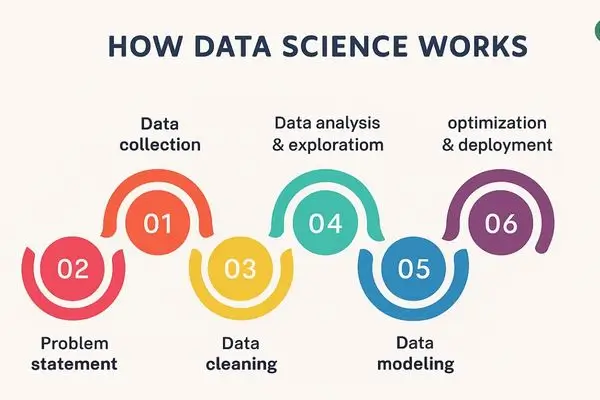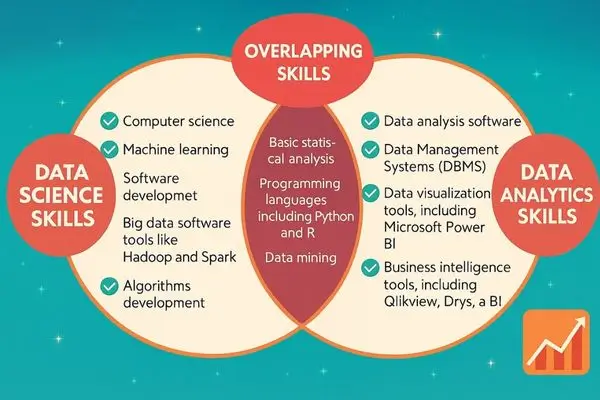Introduction
Data science is transforming the world. It blends math, tech, and creativity to uncover insights from data. Businesses, governments, and even nonprofits rely on it.
But what makes data science so powerful? This blog post by hstech.io dives deep into data science, its impact, and how you can master it.
Topics
Table of Contents
What Is Data Science?
It is the art of extracting meaning from raw data. It uses tools like statistics, machine learning, and programming. Think of it as solving puzzles with numbers and code.
Data scientists analyze trends, predict outcomes, and drive decisions. From healthcare to marketing, every industry uses it.
Why to Learn
Data science powers innovation. It helps companies personalize ads. It predicts disease outbreaks. It even optimizes traffic flow in cities. It behind more intelligent AI and better customer experiences. It’s a skill that opens doors to high-demand careers.

Key Components
It has five core pillars. Let’s break them down:
1. Data Collection
Everything starts with data. Data scientists gather information from databases, APIs, or web scraping. Quality data is key. Insufficient data leads to bad results.
2. Data Cleaning
Raw data is messy. It’s full of errors, duplicates, or missing values. Cleaning ensures data is accurate and usable. This step takes time but saves headaches later.
3. Data Analysis
This is where the magic happens. Analysts use statistical methods to find patterns. Tools like Python, R, or SQL make it easier. Insights from this step guide decisions.
4. Machine Learning
Machine learning lets computers learn from data. It’s used for predictions, like recommending movies or detecting fraud. Algorithms are the backbone of this process.
5. Data Visualization
Numbers alone don’t tell the story. Charts, graphs, and dashboards make insights clear. Tools like Tableau or Power BI help communicate findings effectively.
Why It Is Unique
Data science is more accessible than ever. Cloud platforms like AWS and Google Cloud simplify data storage. AI tools automate repetitive tasks. Real-time analytics are now standard. Plus, ethical data use is a hot topic. Companies prioritize privacy and transparency to build trust.
The Role of AI
AI and data science are intertwined. AI automates data analysis. It speeds up predictions. For example, generative AI creates reports or visualizes data instantly. But human oversight remains crucial. AI isn’t perfect, so it needs data scientists to guide it.
How to Start a Career in this field
Want to become a data scientist? Here’s a roadmap:
Step 1: Learn the Basics
Start with math and stats. Focus on probability, linear algebra, and calculus. These are the foundations of data science.
Step 2: Master Programming
Python and R are must-haves. Learn libraries like Pandas, NumPy, and Scikit-learn. SQL is great for handling databases.
Step 3: Understand Machine Learning
Study algorithms like regression, decision trees, and neural networks. Platforms like Coursera or Kaggle offer great courses.
Step 4: Build Projects
Hands-on experience matters. Create projects like predicting house prices or analyzing social media trends. Share them on GitHub.
Step 5: Stay Updated
Data science evolves fast. Follow blogs, attend webinars, or join communities on X. Stay curious and keep learning.

Essential Tools
Here’s a quick list of essential tools:
- Python: Versatile and beginner-friendly.
- R: Great for statistical analysis.
- SQL: Perfect for querying databases.
- Tableau: Top choice for visualization.
- TensorFlow: Ideal for machine learning models.
- Jupyter Notebook: Best for coding and testing.
Real-World Examples
It solves real problems. Here are some unique applications:
Healthcare
Data science predicts disease outbreaks. It analyses patient data to personalize treatments. For example, AI models detect cancer early with 95% accuracy.
E-Commerce
Ever wonder how Amazon suggests products? Data science. It studies your browsing habits. It predicts what you’ll buy next.
Urban Planning
Cities use data science to reduce traffic. Sensors collect real-time data. Algorithms optimize traffic signals, cutting congestion by 20% in some cities.
Entertainment
Netflix uses data science to recommend shows. It analyses viewing patterns. This keeps users hooked and reduces churn.
Challenges
It isn’t all smooth sailing. Here are common hurdles:
Data Privacy
Regulations like GDPR demand careful data handling. Breaches can cost millions. Data scientists must prioritize ethics.
Skill Gaps
The field moves fast. Keeping up with new tools is tough. Continuous learning is a must.
Bias in Algorithms
AI can inherit biases from data. For example, biased hiring algorithms favour certain groups. Data scientists must audit models regularly.
The Future of this tech
What’s next for data science? Here are trends to watch:
Automated Machine Learning (AutoML)
AutoML simplifies model-building. Tools like Google’s AutoML let non-experts create models. This democratizes data science.
Edge Computing
Data processing is moving to devices like phones or IoT sensors. This reduces latency and boosts real-time analytics.
Ethical AI
Governments are pushing for fair AI. Data scientists will focus on transparency and bias reduction.
Quantum Computing
Quantum computers could revolutionize data processing. They’ll solve complex problems faster than ever.
Tips for Creating Unique Content
Want to stand out? Here’s how to craft original content:
- Share Personal Insights: Add your experiences or case studies. This makes content authentic.
- Use Fresh Angles: Instead of “What is data science?”, try “How data science saved my business.”
- Incorporate Visuals: Infographics or custom charts grab attention.
- Engage with Questions: Ask readers, “What data science tool do you love?” This sparks interaction.
How DS Boosts Business Growth
Data science drives profits. Here’s how:
- Better Decisions: Data-backed choices reduce risks.
- Customer Insights: Understand what customers want. Tailor products to their needs.
- Cost Savings: Optimise operations. For example, predictive maintenance cuts downtime by 30%.
- Revenue Growth: Personalized marketing boosts sales. Companies see 10-20% revenue lifts.
Communities to Join
Connect with others to grow your skills:
- Kaggle: Compete in data science challenges.
- Reddit: Join r/datascience for tips and discussions.
- X Communities: Follow #DataScience or #MachineLearning hashtags.
- Local Meetups: Attend events in your city for networking.
FAQs
1. What is Data Science, and Why Is It Important?
Data science is the art of turning raw data into actionable insights using tools like AI and statistics. It’s a game-changer because businesses rely on it to predict trends, improve products, and stay competitive. With the global data volume hitting 181 zettabytes, it’s like having a superpower to navigate this data flood—pretty cool, right?
2. What Skills Do I Need to Start a Career in Data Science?
To kick off, you’ll need basics like Python or R for coding, SQL for databases, and a grip on statistics. Add tools like TensorFlow for machine learning and soft skills like problem-solving. AI integration makes AutoML a hot skill too—start with free courses on platforms like Coursera to build your foundation!
3. What Are the Top Data Science Trends to Watch?
This year, look out for AI/ML integration for smarter workflows, TinyML for edge devices, and augmented analytics for easy insights. Predictive analytics is booming, hitting a billion-dollar market, while data privacy with GDPR 2.0 keeps ethics front and center. These trends shape how data science solves real-world problems!
4. How Much Can I Earn as a Data Scientist?
Salaries are sweet—data scientists average $100,000 in the US, thanks to demand. Entry-level roles start around $60K, while experts with AI skills can hit $150K+.
5. What Challenges Should I Expect in Data Science, and How Can I Overcome Them?
Challenges include data overload—cleaning messy datasets takes time—and keeping up with fast-changing tech like quantum computing. Overcome this by mastering data prep tools (e.g., Pandas) and upskilling with online courses. Networking on LinkedIn and joining data communities also helps you stay ahead!
Conclusion
Data science is the key to unlocking insights. It’s a blend of tech, math, and curiosity. From healthcare to e-commerce, it’s changing lives. Start learning today. Build projects, join communities, and stay updated. The future is data-driven—be part of it.
Ready to dive into data science? Start with a Python course. Join Kaggle for hands-on practice. Share your journey on X with
Pingback: Best Data Science Tools: The Top 10 Must-Haves for Beginners and Pros
Pingback: Artificial Intelligence Engineer Jobs: Unique Trends, and 4 top skills